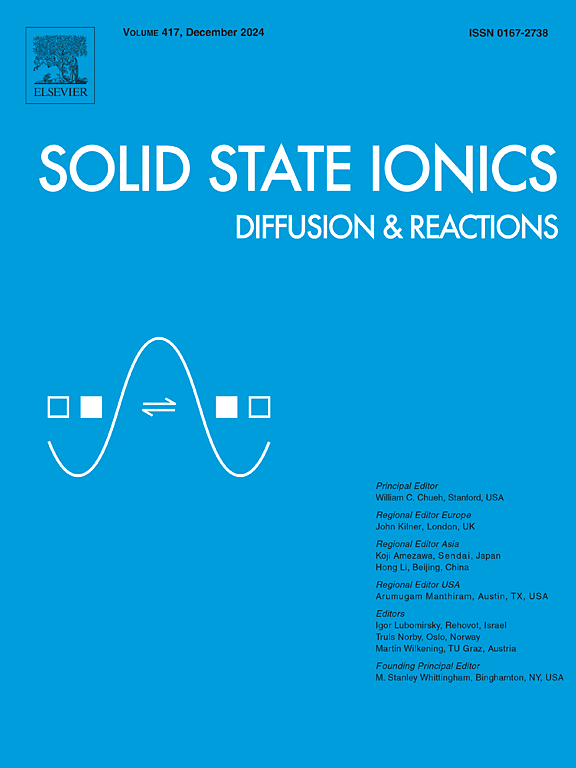Distinct influence of Cd in the electrocatalyst of Ni-Co-Cd/CNFs nanoparticles as a catalyst in direct alcohol fuel cells (DAFCs)
IF 3
4区 材料科学
Q3 CHEMISTRY, PHYSICAL
引用次数: 0
Abstract
Different percentages of less expensive metal alloy-decorated nanofiber catalysts have been successfully manufactured using the electrospinning method to replace platinum in direct alcohol fuel cells (DAFC). The synthesis and characterization of catalysts, namely Ni-Co-Cd/CNFs, with a metal fixed ratio of 20 % wt. for DAFC applications are the main goals of this work. Two different catalyst concentrations were prepared with fixed nickel concentrations (Ni12Co6Cd2 & Ni12Co4Cd4). This research represents the first preparation of ternary Ni-Co-Cd/CNF for DAFC applications. Various methods, including electrochemical tests, transmission electron microscopy, scanning electron microscopy, and x-ray diffraction, are used to characterize the catalysts. Scanning electron microscopy (SEM) revealed that the fabricated sample exhibited a good nanofiber form and a distinct nanoparticle look. The samples' capacity for alcohol electrocatalysis was assessed using cyclic voltammetry, impedance spectroscopy, chronoamperometry, scan rate, and response time. The oxidation peak current density and electrode stability both rise when the concentration of Cd in Ni-Co-Cd/CNF increases. The oxidation peak current density of Ni12Co4Cd4 at the optimum ethanol concentration (1 M ethanol in 1 M KOH) is found to be 29.7 mA/cm2. While the maximum current density is found to equal 38.86 mA/cm2. In addition, the CV results yield the oxidation peak current density to be 3.5 mA/cm2 at the optimum methanol concentration (1 M methanol in 1 M KOH). Ni12Co4Cd4 exhibits promoted electrochemical properties to ethanol electrooxidation rather than methanol oxidation. Furthermore, these findings are enhanced by the highly calculated diffusion coefficient of Ni12Co4Cd4 towards ethanol in comparison with methanol (2.30 × 10−6 cm2/s for ethanol and 3.07 × 10−7 cm2/s for methanol). This work has demonstrated how to use a unique technique to develop an efficient alcohol electrooxidation catalyst based on nickel, cobalt, and cadmium nanoparticles.

镉对Ni-Co-Cd/CNFs纳米颗粒电催化剂直接乙醇燃料电池(DAFCs)的显著影响
采用静电纺丝法成功制备了不同比例的廉价金属合金装饰纳米纤维催化剂,用于替代直接酒精燃料电池(DAFC)中的铂。本工作的主要目标是合成和表征金属固定比为20% wt用于DAFC的Ni-Co-Cd/CNFs。采用固定镍浓度(Ni12Co6Cd2 &;Ni12Co4Cd4)。本研究首次制备了用于DAFC的三元Ni-Co-Cd/CNF。各种方法,包括电化学测试、透射电子显微镜、扫描电子显微镜和x射线衍射,被用来表征催化剂。扫描电子显微镜(SEM)显示,制备的样品具有良好的纳米纤维形态和独特的纳米颗粒外观。使用循环伏安法、阻抗谱法、计时安培法、扫描速率和响应时间来评估样品的醇电催化能力。随着Ni-Co-Cd/CNF中Cd浓度的增加,氧化峰电流密度和电极稳定性均有所提高。在最佳乙醇浓度(1 M乙醇,1 M KOH)下,Ni12Co4Cd4氧化峰电流密度为29.7 mA/cm2。而最大电流密度为38.86 mA/cm2。此外,CV结果表明,在最佳甲醇浓度(1m甲醇/ 1m KOH)下,氧化峰电流密度为3.5 mA/cm2。Ni12Co4Cd4表现出乙醇电氧化而非甲醇电氧化的电化学特性。此外,与甲醇相比,Ni12Co4Cd4对乙醇的扩散系数(乙醇为2.30 × 10−6 cm2/s,甲醇为3.07 × 10−7 cm2/s)也增强了这些发现。这项工作展示了如何使用一种独特的技术来开发基于镍、钴和镉纳米颗粒的高效乙醇电氧化催化剂。
本文章由计算机程序翻译,如有差异,请以英文原文为准。
求助全文
约1分钟内获得全文
求助全文
来源期刊

Solid State Ionics
物理-物理:凝聚态物理
CiteScore
6.10
自引率
3.10%
发文量
152
审稿时长
58 days
期刊介绍:
This interdisciplinary journal is devoted to the physics, chemistry and materials science of diffusion, mass transport, and reactivity of solids. The major part of each issue is devoted to articles on:
(i) physics and chemistry of defects in solids;
(ii) reactions in and on solids, e.g. intercalation, corrosion, oxidation, sintering;
(iii) ion transport measurements, mechanisms and theory;
(iv) solid state electrochemistry;
(v) ionically-electronically mixed conducting solids.
Related technological applications are also included, provided their characteristics are interpreted in terms of the basic solid state properties.
Review papers and relevant symposium proceedings are welcome.
 求助内容:
求助内容: 应助结果提醒方式:
应助结果提醒方式:


